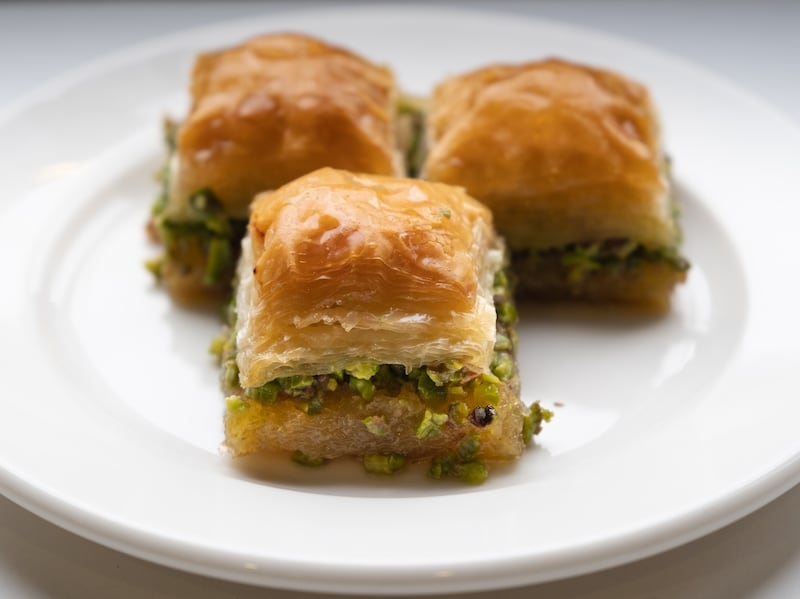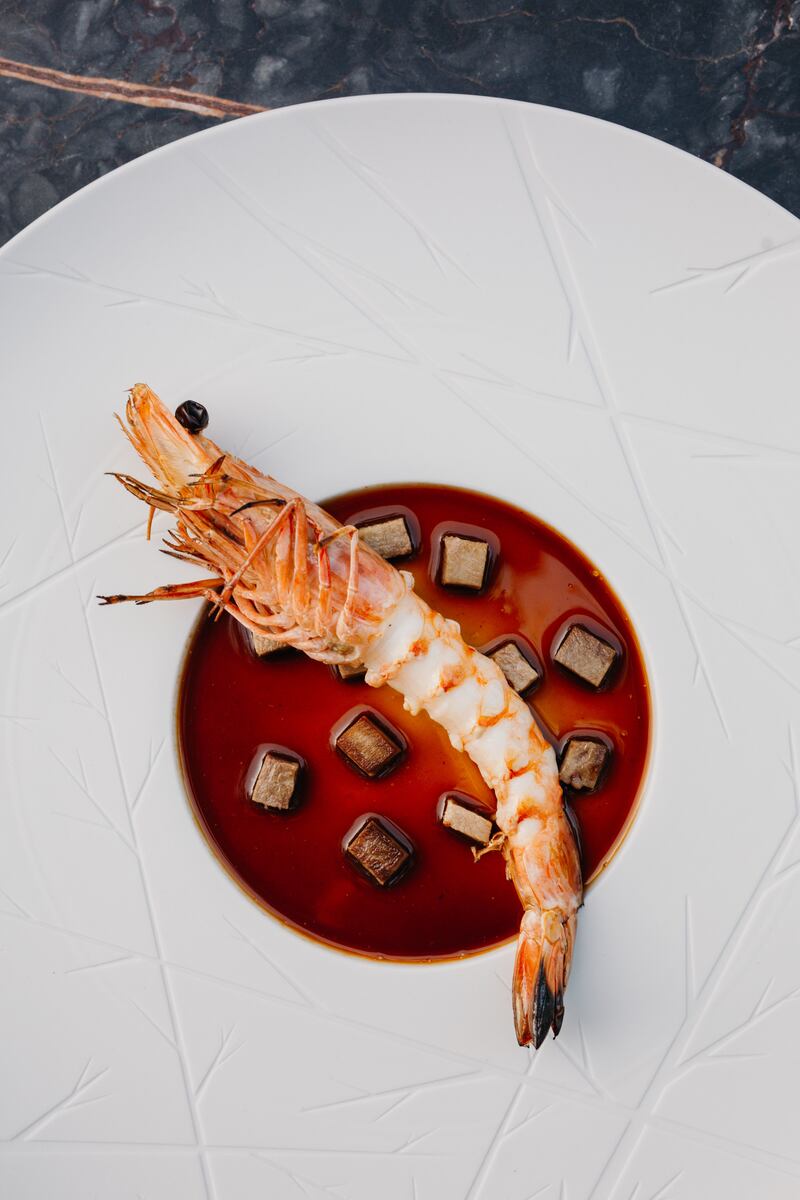Turkish people eat baklava every day. It is not just for tourists. They take it to a funeral, a celebration or a wedding; it is the only dessert that is appropriate for all occasions. It should be eaten with your hands – no fork is necessary – and it should be placed in your mouth upside down to let the savoury side hit your tongue. It is all about the senses; the smell, the taste and the sound of the layers crunching together as you bite. If this doesn’t sound familiar, it is likely that you have yet to taste baklava that has been made by a master.
It takes a minimum of six years to become a baklava master, with each step of the process requiring serious precision. It is physical work, with the filo dough for the 40 layers of each pastry being rolled out so thinly that it is possible to read a newspaper through it. This is not an urban myth; I saw it for myself in Güllüoğlu Baklavacısı, Istanbul’s most famous baklava bakery, which first opened in 1843, in the Karaköy neighbourhood.
Apprentices, masters and veterans work to retirement. The only way to work in Güllüoğlu is to be trained up from the beginning. Some stay way past retirement age – the shop manager has been working there for 64 years. It is like a family, with relatives, brothers, cousins and neighbours all working in the glass-fronted rooms, where you can see delicate puffs of flour billowing into the air as the masters dust the delicate opaque sheets of filo. Each master has their own long, narrow rolling pin with their name etched on it. Each sheet is rolled out by hand. A special brush is used to dust the excess flour from the marble-topped table.
The craft has traditionally been the preserve of males, as there is a serious level of muscle power required for the job, but more recently, women have started training in the art.
It is not just about the gossamer sheets of filo pastry. Ghee, the clarified butter made from the milk of mountain sheep, is essential to ensure the savoury flavour and the right degree of crispness. It is a valuable commodity that is reserved and paid for one year in advance to ensure supply. It is collected from the villagers in May and June, when the grass is green and the milk has the best flavour. Back at the bakery, the ghee is sealed in buckets and stored for a year to mature.

The pistachio harvest, which takes place in July and August in Gaziantep in south-central Turkey, is equally important. Similarly, orders are placed in advance, and, when the young pistachios are delivered they are stored to retain freshness. They are not cracked or ground until the day they are required so that they retain their aroma and taste.
The pistachios are added after 20 layers of filo have been laminated with the ghee, and then another 20 layers of filo are laid gently on top of this. It is like making a mystical bed. A special handcrafted knife is used to slice the dough on the large trays into small squares. It takes a year to learn how to slice properly. Ghee is poured over to ensure it penetrates the sheets of filo, and the tray of baklava is cooked for 35 minutes at 165 degrees. The oven takes 60 trays at a time with Güllüoğlu producing two tonnes of baklava a day.
[ Living the high life on a hot-air balloon trip over TurkeyOpens in new window ]
When it’s crisp and golden, the baklava comes out of the oven, and boiling sugar beet syrup (not honey) is poured over. Different types of baklava require different densities of sugar syrup and, after half an hour, the baklava has absorbed the syrup. It is crisp and dry. It is sold by the kilogramme, not by the piece, and served with buffalo clotted cream and honey.
Baklava has never been a street food. It has always been expensive to make, made by masters in the palaces of Turkey. It did not become available to buy until the mid-1800s. There are numerous types of baklava, including savoury versions that are eaten for breakfast. To really enjoy baklava, you should practice keyif, the Turkish art of meaningful idleness, and relish a simple moment of pleasure as you sip Turkish çay (tea) from a tulip-shaped glass.

I can also highly recommend that you sip çay while you eat simit, the Turkish bread rings that are cooked in a wood-burning oven and are often compared to a bagel. Head to Tarihi Galata Simitçisi near the Galata Tower for the best Istanbul has to offer.
Turkey is a melting pot of cultures and cuisines, and the aroma of a charcoal grill is never far away. Cross the Bosphorus and head to Çiya Sofrasi, Musa Dağdeviren’s traditional restaurant in Kadiköy’s market district. He was featured on Netflix’s Chef’s Table, and is considered to be a culinary anthropologist on Turkish food. He has researched home and street cooking extensively, and contests the theory that a man called Iskender was the originator of the upright döner kebab in Bursa in the 1860s, after unearthing an 1855 photograph which displays an engraving of a döner.
There are many different types of Turkish kebabs, and for the rarer cağ kebab, enthusiasts head to the pedestrianised alleys of Sirkeci. It looks like a horizontal doner kebab, similar to an Argentinian asado or Brazilian churrasco, and Erzurum Cağ Kebapçısı, at the entrance to Hocapaşa Sokak, is one of the top places to try it.
If you are up for a trek, take the T1 tram to the end of the line at Güngören’s Köyiçi neighbourhood, where grill houses serve traditional specialities from Turkey’s culinary capital, Gaziantep. Bağdat Ocakbaşı is one of the most popular places for Adana dürüm. More accessible is Develi restaurant at Samatya, which is the original restaurant in the Develi group.

For the best esnaf lokanta (tradesmen’s restaurants), head to the commercial district of Beyoğlu, where you will get homestyle dishes such as stuffed aubergine, stewed lamb with rice and braised vegetables. For something decidedly more glamorous, Lokanta 1741 in the 300-year-old Cagaloglu Hammam is quite wonderful, particularly dining on the upstairs terrace on a sunny day.
Tradition is a huge influence on the young chefs who are putting Turkey on the culinary map. In 2022 Michelin launched its first guide for restaurants in Istanbul. Last year it added the regions of Izmir and Bodrum to the guide, bringing the haul of gongs to a two-Michelin-star restaurant in Istanbul and 11 one-Michelin-star restaurants spread across Istanbul, Izmir and Bodrum.
A visit to Neolokal in Istanbul, which was awarded a star in 2022, gave me a sense of how chefs are reinterpreting tradition, but a visit to the lush area around Urla (in Izmir province on the west coast of Turkey by the Aegean Sea), where olive oil has been produced since the sixth century, was a revelation of what is truly new about the food scene in Turkey.
At OD Urla, a one-Michelin-star restaurant down a winding road in the middle of the wine route in Urla, Osman Sezener references culinary traditions by grilling over fire and using a wood-burning oven in his open kitchen. His restaurant is buzzy, in a greenhouse environment, albeit with white table linen. Surrounded by vineyards and olive groves, the outdoor seating area is in his garden, where all the produce is grown.

Local blue shrimp get a gentle touch of smoke from the grill, octopus and squid are charred, and grouper, which has been aged for two days, is cooked in a wood-burning grill so that the exterior is almost caramelised. There are sauces and riffs that bring nuance and vibrant flavours. When it comes to dessert, it’s baklava, served as a baklava ice-cream, topped with crispy chards of filo, and pistachio and pastry cream made from lor, a Turkish curd cheese. It’s a tasty interpretation.
For somewhere more intimate and utterly charming, visit Vino Locale, the one-Michelin-star restaurant owned by Seray and Ozan Kumbasar. It is surrounded by ancient olive trees, vineyards and fields groaning with produce. The seasonal menu changes every six weeks. Seray, who landed the Sommelier Award at the most recent Michelin awards, has compiled a thoughtful wine list that highlights indigenous grape varieties and low intervention wine makers.
Nearby is Teruar, a one-Michelin-star restaurant with rooms, which overlooks a gorgeous vegetable garden. Osman Serdaroglu makes full use of the produce, bringing a subtle level of technique to his cooking. On a beetroot dish, some elements are kept raw – celery, beetroot, broccoli and bitter leaves – with beetroot jelly, a celery foam and clever crunchy elements made from tuna leftovers adding a touch of umami and texture.

Sardines are fried in a light tempura batter served with fresh walnut salsa, a trompe l’oeil piede is served sartorially with sautéed forest mushrooms, tortellini are stuffed with red mullet, and for the main dish, grilled lamb is served with rice that has been cooked inside a pomegranate until it is sticky.
Turkish food is beguiling, not just because of the depth and breadth of this expansive country, but because of the abundance of exceptional produce, which weaves effortlessly through deeply rooted tradition. It’s the old-meets-new cliche, but in the most evocative way, from the smoky allure of charcoal-grilled kebabs to the refined artistry of young Michelin-starred chefs. A dynamic filled with culinary narrative.
Corinna Hardgrave was a guest of Go Türkiye, the Turkish Tourism Board
Where to go
- Karaköy Güllüoğlu, Kemankeş Karamustafa Paşa, Kemankeş Cd No: 67, 34425 Beyoğlu/İstanbul
- Tarihi Galata Simitçisi, Kemankeş Karamustafa Paşa, Mumhane Cd 47/A, 34425 Beyoğlu/İstanbul
- Çiya Sofrası, Caferağa, Güneşli Bahçe Sok, 34710 Kadıköy/İstanbul
- Erzurum Cağ Kebapçısı, Topçular, Eyüp Sultan Blv No 81, 34055 Eyüpsultan/İstanbul
- Çiya Sofrası, Caferağa, Güneşli Bahçe Sok, 34710 Kadıköy/İstanbul
- Bağdat Ocakbaşı, Merkez Mahallesi Tayfun Sokak, No 8/10 Güngören/Istanbul
- Develi develikebap.com
- Lokanta 1741, Alemdar, Prof. Kazım İsmail Gürkan Cd. No: 34, 34110 Fatih/İstanbul
- Neolokal, Arap Cami, Mahı, Bankalar Cd. No: 11, 34420, 34421 Beyoğlu/İstanbul
- OD Urla, Rüstem, Süt Pınarı Mevkii, 2018/9 Sokak No: 28, 35430 Urla/İzmir
- Urla Vino Locale, Kuşçular, 8037. Sk. No: 3, 35430 Urla/İzmir
- Teraur Urla, Kuşçular, 8028. Sk. No: 16, 35430 Urla/İzmir


















